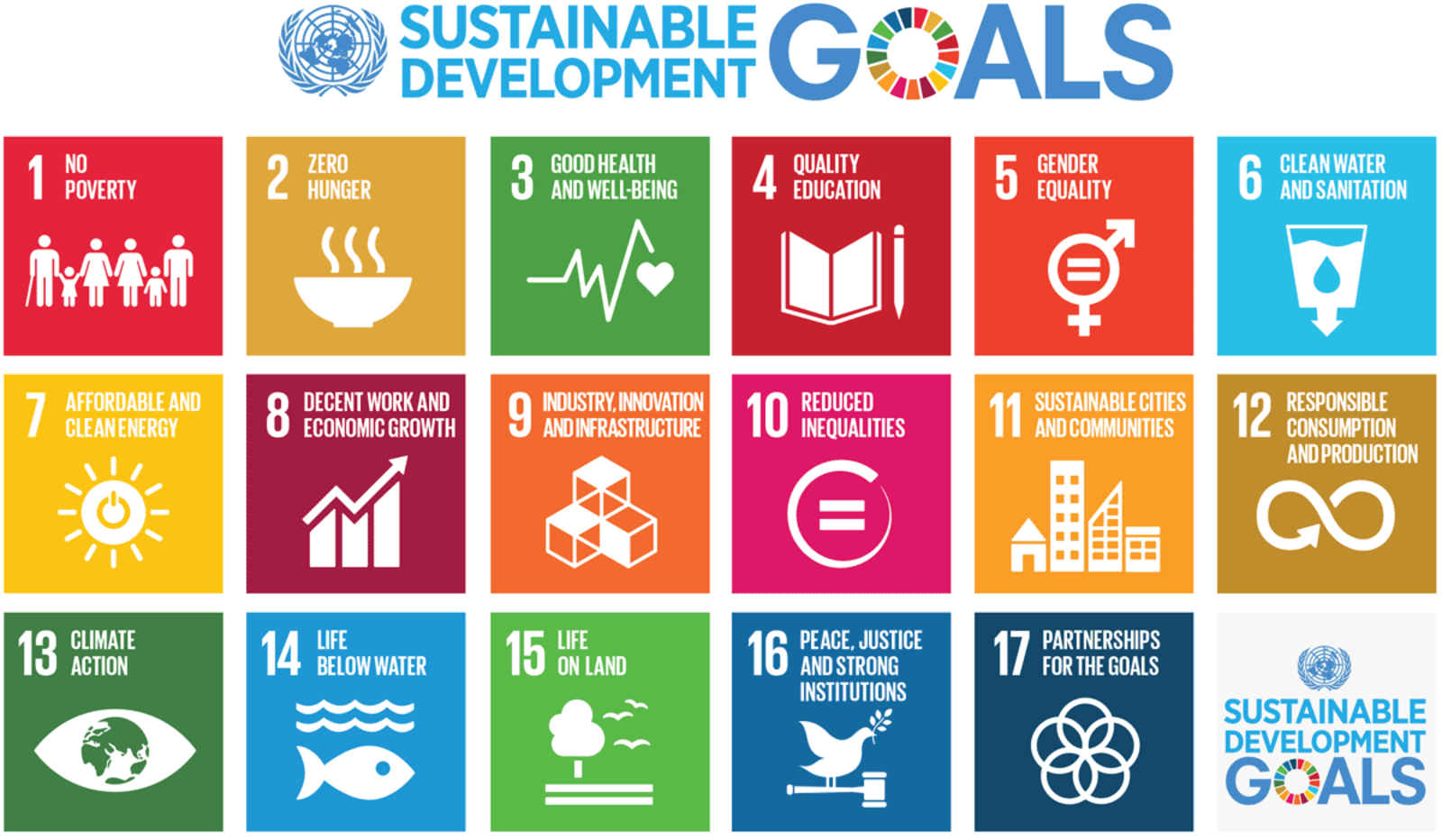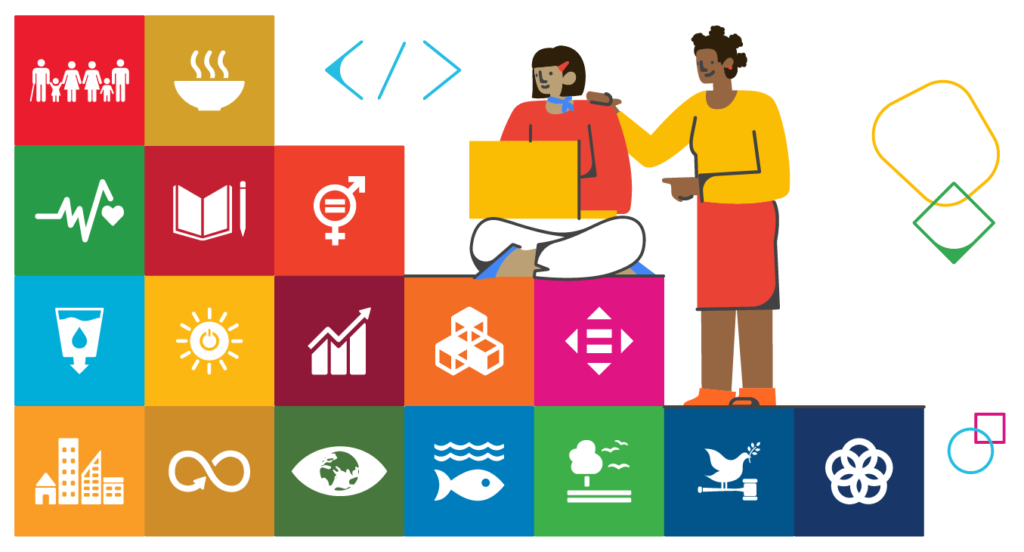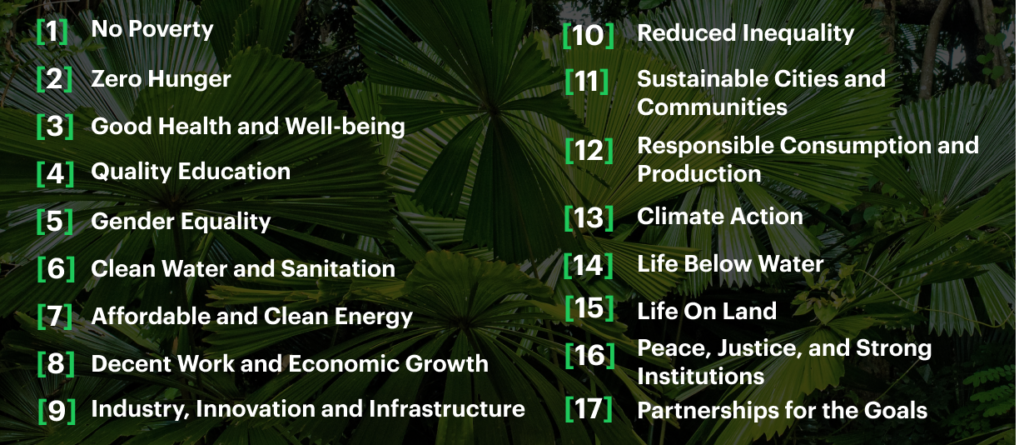
Looking for more information on the UN Sustainable Development Goals? We’ve broken down all 17 of them…
To achieve a greener future the United Nations laid out certain goals that act as a roadmap to a more sustainable life on Earth. They are better known as the UN Sustainable Development Goals or ‘SDGs’ for short.
In total, the SDGs make up 17 interlinked global goals designed to be a “blueprint to achieve a better and more sustainable future for all”. They were set up in 2015 by the United Nations General Assembly (UN-GA) with aims to be achieved by 2030.
Having said all this, here’s a clear breakdown of every UN sustainable development goal, starting with their history.

The SDGs first came into fruition back in 2015. But this doesn’t mean that world leaders weren’t concerned about the environment before this. In fact, the SDGs were developed as part of the Post-2015 Development Agenda to replace or to succeed the Millennium Development Goals that were going to end in 2015.
Discussions regarding the Post-2015 Development Agenda included planning and preparations for the financing of the implementation of new sustainable development goals. It ended with the adoption of the Addis Ababa Action Agenda in July 2015, and ultimately the final document entitled “Transforming our world: the 2030 Agenda for Sustainable Development”, simply called Agenda 2030.
On 25 September 2015, 193 countries from the UN General Assembly adopted Agenda 2030 to shape the future of the earth. The documentation contains the 17 Sustainable Development Goals along with their associated 169 targets and 232 indicators.
Two years after SDGs were set up, the UN General Assembly passed another resolution where it introduced two parameters – Targets and Indicators – to make the interdependent goals more actionable and detail oriented.
The new resolution ties each SDG with a specific target along with indicators that aim to measure the progress made towards each goal. Though these targets are intended to be achieved between 2020 and 2030, for some targets there is no any given deadline.
To monitor the progress made towards achieving these targets, there are also Indicators that can be visualised through online tools or trackers which allow a better understanding and analysis of the data captured. The online publication SDG Tracker shows necessary details regarding all the indicators embedded with the targets

As per the World Bank data, about 9.2% of the present world, which is around 700 million people, are living in extreme poverty on less than $1.90 per day. This means these people struggle to meet even basic necessities of life ie. water, health, education and sanitation.
Goal 1 of SDGs aims to tackle the problem of world poverty in all forms. It has 7 Targets and 13 Indicators.
Malnutrition is responsible for around 3.1 million deaths in children worldwide and 8.9% of the world’s population (around 663 million people) are undernourished.
Goal 2 of Agenda 2030 aims to end world hunger by providing better access to food resources across the globe. It also aims to improve agricultural productivity through sustainable means. It has 8 Targets and 14 Indicators to measure the progress of the Targets.
Goal 3 of the sustainability agenda aims to reduce the mortality rate of the global population. It also aims to fight communicable diseases, promote mental health, and reduce road injuries and related deaths. It has 13 targets and 28 indicators in total.
Goal 4 aims to provide free primary and secondary education for all, affordable higher education and also focuses on creating awareness for sustainable development. It has 10 Targets in total and 11 Indicators.
The results of Goal 4 efforts are satisfactory, with the number of out-of-school children halved from 112 million in 1997 to 60 million in 2014. The global participation in tertiary education has also improved and now it has the gross enrolment ratio of 38%.
To tackle the issue of gender discrimination, SDG 5 aims to empower all women and girls with equal rights and opportunities.
The results obtained show that more women are now in decision making positions at the local bodies with 36% of elected seats, as per data obtained from 133 countries. In 2020, the women representation in lower houses of national parliament was 25%, a slight increase from 2015 where it stood at 22%.
As per a 2017 report from the Joint Monitoring Programme(JMP) of World Health Organisation (WHO) and UNICEF, 4.5 billion people (which is more than half of the world) don’t have proper sanitation systems. The report also mentioned that 2.2 billion people are devoid of safe drinking water.
Goal 6 aims to ensure safe and affordable drinking water to people all around the world and provide access to well maintained sanitation.
As per EIA, the global energy expenditure is expected to increase by 48% before 2040. Since the world is already facing an energy crisis this goal demands further attention towards the use of clean or renewable sources of energy either for electricity generation or transportation purposes.
Goal 7 aims to provide research, development, and investments for endeavours concercering clean energy, with hopes of making it an affordable and reliable source for the masses while increasing the share of renewable energy in the global energy mix. It has 5 total targets to achieve and 6 indicators.
In 2019, it was reported that 22% of youngsters were unemployed. What’s more unfortunate is that this figure has hardly changed since 2005. In the last 5 years, the economic growth in less developed countries has been increasing at the rate of 4.3% on an average which is less than the targeted growth rate of 7% as per Goal 8.
So, Goal 8 wants nations to achieve sustainable economic growth for all to reduce social disparity and aims to provide quality work opportunities with equal pay while ending child labour, modern slavery and trafficking. It has 12 Targets to achieve in total.
Universal access to information and communication technology, sustainable infrastructure development and industrialization, and upgradation of industrial technologies are just a few out of the 8 Targets of Goal 9 whose progress is measured by 12 Indicators.
As per United Nations Economic and Social Council Report 2020, 40% of the world’s population received less than 25% of the overall consumption or income of the world’s population.
The major victims of this discrimination are mainly women and disable-bodied people. The remainder were discriminated against on the basis of their caste, colour, religion and ethnicity.
Goal 10 aims to reduce income equalities and wants to provide equal opportunities for all while also ending discrimination of all forms. It has a total of 7 Targets which it wants to achieve.
In 2019, only half of the world’s population had convenient access to public transportation.
In 2018, 24% of the urban population (which comes to around 1 billion people) were living in slums.
To combat such extreme statistics, Goal 11 aims to improve people’s livelihood and living conditions. It aims to provide affordable housing facilities and access to public transportation systems for each and every member of the society. It has a total of 10 Targets and 14 Indicators to measure those targets.
Every activity that we perform on this planet, like production of food, driving a fuel based vehicle or using an electrical appliance, results in a huge carbon footprint.
Goal 12 has a total of 11 targets, and wants global communities to use Earth’s natural resources efficiently. The goal is to reduce wastage of food and other resources, recycle products and create awareness towards all kinds of sustainable practices for an emission-free and ultimately greener planet.
Between 2000 and 2013, the GHG emissions in developing countries has increased by 43%. In addition, the period spanning 2010 – 2019 was the warmest decade recorded in human history.
The result is climate change or the increase in frequency of disasters like floods, wildfires, hurricanes, droughts, etc. which we are experiencing today.
So, Goal 13 aims to combat climate change and its impacts and has a total of 5 Targets in it.
Overfishing due to illegal fishing and ocean acidification are some of the key challenges for the ecosystem and species living below water. Since the industrial revolution, ocean acidification has increased by 26%.
The oceans cover more than 2/3 of the Earth’s surface and make up 97% of the planet’s water. Rainwater and climate are also regulated by ocean temperatures and current, meaning they keep planet Earth viable.
Having said this, Goal 14 of the SDGs aims to reduce ocean acidification, conserve coastal areas and marine ecosystems, and promote sustainable fishing. There are 7 Targets in Goal 14.
Forests cover 30% of the Earth’s surface and are a home to millions of animal, plants and tree species. They also absorb CO2 from air thus helping to combat climate change.
But there has been a decline in forests in the past decade from 31.9% in 2000 to 31.2%% in 2020 which is loss-equivalent to 100 million hectares of forest. The major reason behind this decline was the change of forest land into land for agriculture usage.
To end deforestation and desertification, start restoring degraded forests, protect biodiversity and natural habitats, and eliminate poaching and trafficking of protected species, we have Goal 15 in the Agenda 2030 where it carries 12 targets to achieve in total.
It was found that the lower-income countries have a high bribery rate. Since we can’t hope for sustainable development without transparency, stability and peace, Goal 16 aims to reduce bribery and develop more accountable and transparent institutions.
Reducing violent crime, sex trafficking, forced labour, and child abuse are some of its other targets. It has 12 targets to achieve in total.
If the world wants to achieve the above 16 SDGs, then cooperation and coordination between resolution members plays a crucial role. And this is what Goal 17 is all about. It has 19 targets in it and 24 indicators to measure those targets.
Goal 17 wants countries and organizations to cooperate instead of compete. It desires all the members to develop multi-stakeholder partnerships to share knowledge, expertise, technology, and financial support for the overall success of the SDGs.
At One Tribe we are strive to protect and preserve rainforest across the world.
We are on the same mission to make this planet more sustainable by mainly contributing towards 5 out the total 17 Goals. That 5 include [1] No Poverty, [13] Climate Action, [14] Life Below Water, [15] Life on Land, and [17] Partnership for the Goals.
To learn more about our goals check out our commitment page.
b corp activewear brands, successful b corp activewear brands, how do i get b corp certified, what activewear brands are involved with fast fashion, list of sustainable activewear brands, where can i buy sustainable active wear, slow fashion b corps, how to combat fast fashion, activewear brands that don’t harm the environment, why is becoming a b corp so important
One Tribe is a Climate Action Platform enabling businesses and their customers to make a positive environmental impact.
Eric currently works as an independent consultant at the intersection of nature and climate, focused on catalysing market and non-market solutions to drive the just transition.
He previously was Head of Product at Earthshot Labs, supporting nature conservation and restoration projects across the global south secure project finance. Prior to Earthshot Labs, Eric led nature-based carbon project development for Gorongosa National Park in Mozambique and founded the Carbon Cooperative, a global alliance of leading nature conservation and restoration practitioners exploring carbon finance. After serving in the Peace Corps in Mozambique out of university, he spent much of his 20s working in community-based conservation and ecosystem restoration efforts in Sub-Saharan Africa interspersed with two startup ventures as co-founder and CEO of a mental health tech startup and COO of a sustainable coffee company. Eric has a dual Masters in Environmental Engineering and Environmental Policy from Stanford University where he was a NSF Graduate Research Fellow and a BS in Environmental Engineering from Tufts University.
Alan is a risk management thought-leader, superconnector, and FinTech pioneer. His mission is to enable an Earth Positive economy which includes nature in global accounting systems.
Alan is Founder of Generation Blue, a venture studio dedicated to planetary game changers powered by exponential technologies. Previously, Alan established Natural Capital Markets at Lykke AG, pioneering blockchain based forestry and carbon backed tokens. Alan has over two decades of risk management experience advising global financial institutions, and was a founding member of the RiskMetrics Group, a JPMorgan spin-off. Alan is an investor and advisor to regenerative impact ventures, including TreeBuddy.Earth, Regenativ, and Vlinder Climate.
Lori Whitecalf made history when she became the first woman to be elected Chief of Sweetgrass First Nation in 2011. She served three terms of office from 2011-2017.
Lori took a two-year hiatus from leadership to expand the family ranch and serve as the FSIN Senior Industry Liaison. She was re-elected on November 29. 2019 and again on November 30, 2021, as Chief of Sweetgrass. Chief Whitecalf practises a traditional lifestyle of hunting, fishing and gathering. She currently sits on the following boards: Saskatchewan Indian Institute of Technology, FSIN Lands and Resource Commission, Battle River Treaty 6 Health Centre and Battleford Agency Tribal Chiefs Executive Council, FSIN Women’s Commission.
Tina is the Chief Business Officer for MLTC Industrial Investments, the Economic Development arm of the Meadow Lake Tribal Council. She has a diverse background of experience. Having spent 15 years as a municipal Chief Operating Officer, 20 years involved in Saskatchewan’s Health Authority Board Keewatin Yatthe and 9 years with Northern Lights Board of Education.
She continues as a Board Member with Beaver River Community Futures supporting small business development in her home region. Tina brings a wealth of experience in a variety of fields and many connections to the Indigenous communities of Northern Saskatchewan. In addition Tina holds a BA Advanced from the U of S, a Certificate in Local Government Authority from the U of R and is certified as a Professional Economic Developer for Saskatchewan and a certified Technician Aboriginal Economic Developer (TAED).
Tootoosis’ career spans 40+ years in HRM, political leadership, and Indigenous economic development, as a dedicated bridge builder and advocate for Indigenous causes.
As a key member of the Saskatoon Regional Economic Development Authority (SREDA) team since 2021, he develops strategies for the Truth and Reconciliation Commission final report and Call to Action #92.
He is a graduate of the First Nations University of Canada and a certified Professional Aboriginal Economic Developer. Spearheading various community initiatives while serving as a Chair of the SIEDN while directing ILDII and WIBF. Founder of MGT Consulting Tootoosis is based in Saskatoon, Treaty Six Territory.
Cy Standing (Wakanya Najin in Dakota) has a long and distinguished career including serving overseas as an Electronics Technician in the Royal Canadian Air Force, former Chief of Wahpeton Dakota Nation, former Vice Chief of the Federation of Saskatchewan Indigenous Nations (FSIN), past Executive Director of Community Development Branch of the Department of Northern Saskatchewan as well as an Order in Council appointment to the Federal Parole Board.
Mr. Standing has served as a Director on many Profit and Non-Profit Corporate Boards, including serving as a Director for Affinity Credit Union with assets of over six billion dollars as well as IMI Brokerage and Wanuskewin and is currently a member of the One Tribe Indigenous Carbon Board.